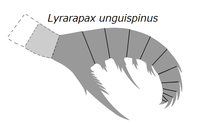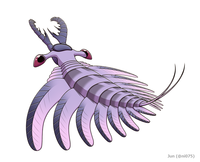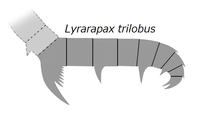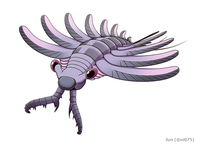ライララパクス
出典: フリー百科事典『ウィキペディア(Wikipedia)』 (2023/04/11 07:48 UTC 版)
生態
ライララパクスは活動的な遊泳性捕食者であったと考えられる[6]。柄部に屈曲した関節をもつ捕獲用の前部付属肢は、現生節足動物であるカマキリの前脚やサソリモドキの触肢のように獲物を捕え、アノマロカリスやアンプレクトベルアのラディオドンタ類と同様、頭部の小さな甲皮は、防衛に用いられる同時に前部付属肢の広い可動域をも維持できたと考えられる[6]。また、L. unguispinus の幼生化石にも発達した前部付属肢をもつため、本種は幼生から既に捕食者であったことも示唆される[6]。
分類
| |||||||||||||||||||||||||||
| ラディオドンタ類におけるライララパクスの系統的位置(Moysiuk & Caron 2022 に基づく)[11] |
ラディオドンタ類の中で、ライララパクスはアンプレクトベルア科(Amplectobeluidae)に分類される[3]。一方、ライララパクスは同科とされるアンプレクトベルアとラムスコルディア(Ramskoeldia)において特徴的な顎基様の構造体(gnathobase-like structures)はなく、歯の構造も異なるなどの相違点を基に、この系統的位置は疑問視すべきという見解もある[15]。しかし、ライララパクスがアンプレクトベルア科に含まれることは、ほとんどの系統解析から支持を得られている[3][16][10][6][17][18][11][19]。
ライララパクス(ライララパクス属 Lyrarapax)には L. unguispinus と L. trilobus という2種が知られ、主に前部付属肢の形態を基に区別される[4]。
- 本属の模式種(タイプ種)。前部付属肢は少なくとも12節(柄部1節+残り11節)があり、内突起は柄部直後の5節のみに生える。そのうち最初の内突起は L. trilobus より長く、前側の分岐は6-7本、残りの肢節と鋏に似た構造をなしている。直後4節の内突起は三叉状で長短を繰り返す。残りの肢節は腹側に内突起は無く、代わりに L. trilobus より発達した背側の棘をもつ。最終肢節は1本の爪に似た形をとる。尾部は1対の尾毛をもつことが分かる他、標本 YKLP 13304 からは尾扇を構成した、3対の尾鰭に似た不確実な構造体が確認される[3]。体長最大8.3cm[10]。
- Lyrarapax trilobus [4](ライララパクス・トライロバス)
- 前部付属肢は少なくとも11節(柄部2節+残り9節)があり、L. unguispinus に比べると、全体はまっすぐに伸びて内突起は比較的に短い。柄部は不明瞭だが2節が知られ、そのうち第2節は内突起をもつ。柄部直後の発達した内突起は L. unguispinus より短く、前側の分岐は7本。それ以降の肢節は断続的に1対の単純な内突起を生えたり欠けたりする。最終4肢節のうち前3節は L. unguispinus より目立たない背側の棘をもち、最終肢節は1本の爪と1対の内突起をもつ。左右の甲皮と尾部は不明。体長最大約6cmと推測される[4]。
- 化石標本 YKLP 13321 の胴部の背側には1対の溝が走り、胴部が縦に3部分に分かれるように見える。種小名「trilobus」(三つの葉)はその特徴に由来する[4]。
脚注
- ^ a b c Yang, Chuan; Li, Xian-Hua; Zhu, Maoyan; Condon, Daniel J.; Chen, Junyuan (2018-03-15). “Geochronological constraint on the Cambrian Chengjiang biota, South China”. Journal of the Geological Society 175 (4): 659–666. doi:10.1144/jgs2017-103. ISSN 0016-7649.
- ^ a b Ortega-Hernández, Javier (2016). “Making sense of ‘lower’ and ‘upper’ stem-group Euarthropoda, with comments on the strict use of the name Arthropoda von Siebold, 1848” (英語). Biological Reviews 91 (1): 255–273. doi:10.1111/brv.12168. ISSN 1469-185X.
- ^ a b c d e f g h i j k l m n o p q r s t Peiyun Cong; Xiaoya Ma; Xianguang Hou; Gregory D. Edgecombe; Nicholas J. Strausfeld (2014). “Brain structure resolves the segmental affinity of anomalocaridid appendages”. Nature 513 (7519): 538–42. doi:10.1038/nature13486. PMID 25043032.
- ^ a b c d e f g h i j k l m n o p q Cong, Peiyun; Daley, Allison C.; Edgecombe, Gregory D.; Hou, Xianguang; Chen, Ailin (2016). “Morphology of the radiodontan Lyrarapax from the early Cambrian Chengjiang biota”. Journal of Paleontology: 1. doi:10.1017/jpa.2016.67.
- ^ a b 土屋 健 (サイエンスライター) (2020-2-12). アノマロカリス解体新書. 田中 源吾 (監修), かわさき しゅんいち (イラスト). 東京: ブックマン社. ISBN 978-4-89308-928-1. OCLC 1141813539
- ^ a b c d e f g h i j k l m n o p q r s t u Liu, Jianni; Lerosey-Aubril, Rudy; Steiner, Michael; Dunlop, Jason A.; Shu, Degan; Paterson, John R. (2018). “Origin of raptorial feeding in juvenile euarthropods revealed by a Cambrian radiodontan” (英語). National Science Review. doi:10.1093/nsr/nwy057.
- ^ “Nature报道云南大学关于节肢动物起源的最新研究成果 - 生物通”. m.ebiotrade.com. 2021年5月27日閲覧。
- ^ “澄江生物群發現多種類奇蝦化石” (中国語). 2021年5月27日閲覧。
- ^ Ortega-Hernández, Javier; Janssen, Ralf; Budd, Graham E. (2017-05-01). “Origin and evolution of the panarthropod head – A palaeobiological and developmental perspective” (英語). Arthropod Structure & Development 46 (3): 354–379. doi:10.1016/j.asd.2016.10.011. ISSN 1467-8039.
- ^ a b c Lerosey-Aubril, Rudy; Pates, Stephen (2018-09-14). “New suspension-feeding radiodont suggests evolution of microplanktivory in Cambrian macronekton” (英語). Nature Communications 9 (1): 3774. doi:10.1038/s41467-018-06229-7. ISSN 2041-1723.
- ^ a b c d Moysiuk, Joseph; Caron, Jean-Bernard (2022-07-08). “A three-eyed radiodont with fossilized neuroanatomy informs the origin of the arthropod head and segmentation” (English). Current Biology 0 (0). doi:10.1016/j.cub.2022.06.027. ISSN 0960-9822. PMID 35809569.
- ^ Zeng, Han; Zhao, Fangchen; Yin, Zongjun; Zhu, Maoyan (2018/01). “A new radiodontan oral cone with a unique combination of anatomical features from the early Cambrian Guanshan Lagerstätte, eastern Yunnan, South China” (英語). Journal of Paleontology 92 (1): 40–48. doi:10.1017/jpa.2017.77. ISSN 0022-3360.
- ^ Sun, Zhixin; Zeng, Han; Zhao, Fangchen (2020-11-15). “A new middle Cambrian radiodont from North China: Implications for morphological disparity and spatial distribution of hurdiids” (英語). Palaeogeography, Palaeoclimatology, Palaeoecology 558: 109947. doi:10.1016/j.palaeo.2020.109947. ISSN 0031-0182.
- ^ Jiao, De-guang; Pates, Stephen; Lerosey-Aubril, Rudy; Ortega-Hernandez, Javier; Yang, Jie; Lan, Tian; Zhang, Xi-guang (2021). “The endemic radiodonts of the Cambrian Stage 4 Guanshan biota of South China” (英語). Acta Palaeontologica Polonica 66. doi:10.4202/app.00870.2020. ISSN 0567-7920.
- ^ a b Cong, Pei-Yun; Edgecombe, Gregory D.; Daley, Allison C.; Guo, Jin; Pates, Stephen; Hou, Xian-Guang (2018-06-23). “New radiodonts with gnathobase-like structures from the Cambrian Chengjiang biota and implications for the systematics of Radiodonta” (英語). Papers in Palaeontology. doi:10.1002/spp2.1219. ISSN 2056-2802.
- ^ Van Roy, Peter; Daley, Allison C.; Briggs, Derek E. G. (2015-06). “Anomalocaridid trunk limb homology revealed by a giant filter-feeder with paired flaps” (英語). Nature 522 (7554): 77–80. doi:10.1038/nature14256. ISSN 1476-4687.
- ^ Moysiuk, Joseph; Caron, Jean-Bernard (2021-05). “Exceptional multifunctionality in the feeding apparatus of a mid-Cambrian radiodont” (英語). Paleobiology: 1–21. doi:10.1017/pab.2021.19. ISSN 0094-8373.
- ^ Caron, J.-B.; Moysiuk, J. (2021-09-08). “A giant nektobenthic radiodont from the Burgess Shale and the significance of hurdiid carapace diversity”. Royal Society Open Science 8 (9): 210664. doi:10.1098/rsos.210664.
- ^ Zeng, Han; Zhao, Fangchen; Zhu, Maoyan (2022-09-07). “Innovatiocaris , a complete radiodont from the early Cambrian Chengjiang Lagerstätte and its implications for the phylogeny of Radiodonta”. Journal of the Geological Society. doi:10.1144/jgs2021-164. ISSN 0016-7649.
- ライララパクスのページへのリンク










